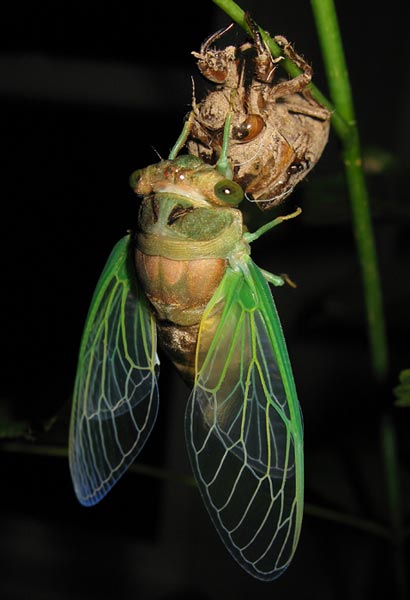
An image from Roy Troutman:
Tibicen tibicen (T. chloromerus, T. chloromera)
Op-Ed Contributor
Here Comes the Buzz
By
CRAIG GIBBS
Published: May 1, 2013
IT may not be as grand as the wildebeest migrations across Africa’s
eastern savanna or the march of emperor penguins across miles of
Antarctic ice to their inland nesting areas. But it is a wildlife
phenomenon not seen elsewhere in the world.
Over the next few weeks, as soil temperatures reach a sustained temperature of 64 degrees,
cicadas from Connecticut to North Carolina will emerge from their
subterranean world for the first time since they burrowed underground as
nymphs in 1996, returning in numbers that dwarf those other spectacles.
The buzzing of males will be heard in a mating ritual that stretches
back to at least the ice age. Then, within six weeks, they will all be
dead, hundreds of millions, if not billions, of them, and their progeny
will not be seen until 2030.
These are the Brood II cicadas,
one of the longest living insects in the world, seen only once every 17
years along the East Coast. (There are 11 other broods that follow the
same cycle, though in different years; this is one of the largest.) Of
the roughly 10 million insect species on earth, cicadas constitute about
3,000. Of those, a mere seven, collectively called periodic cicadas and
found only in eastern North America, spend either 13 or 17 years
growing underground, until it is time for them to emerge and take their
adult form.
They also harbor a mystery that has confounded the
biologists who study them: why did their synchronized life cycles
evolve? One theory among several suggests that it was a response to the
atmospheric cooling during the Pleistocene, to ensure sufficient
populations for successful mating. If so, the cicada may yet reprise its
role as climate indicator if its cycle is disrupted by a warming
planet.
What we do know is this: Their buzzing can reach 90
decibels, equivalent to some power motors. They have been seen in
clusters of up to 1.5 million per acre. As if from some horror movie,
cicada nymphs have been described as “boiling out of the ground.” Snow
shovels are sometimes employed to clear them away.
But there is
no reason to fear these insects, which grow to about 1.5 inches in
length, with big red compound eyes. Cicadas don’t bite. And don’t worry
about your plants. They’ll be fine. There’s no need to reach for the bug
spray.
While the ecological role played by some insects is
important for our own survival (bees and pollination, for instance),
they seldom get the credit or attention they deserve. Bigger creatures
tend to dominate the spotlight. The
fascinating cicada life cycle returns our gaze to the microcosmos
beneath our feet, where these insects are sustained by sucking the
juices of tree roots.
They emerge at night from tunnels they dig to the surface. Once mates have been secured, the females will deposit their eggs in the twigs of trees and shrubs, laying up to 600 eggs each. This
does little permanent damage to trees; some small branches may be
broken, but the end result is often the same as that from pruning —
healthier plants.
The cicadas also provide an overwhelming smorgasbord for other animals. (Another theory about the evolution of their long life cycle and mass synchronous emergence is that it confounds predators —
birds, reptiles, mammals, even other insects — and that, even though
these predators may consume cicadas voraciously, there are so many of
them that the population is not seriously depleted.)
They are
also a culinary cornucopia for the adventuresome among us. You can find
recipes for cicada dumplings, tacos and stir-fries, among other dishes,
on the Web. The Onondaga Indians of New York credit the arrival of
cicadas as having once saved them from famine.
These insects offer other benefits, too. By tunneling to the surface, nymphs aerate the soil.
Predators that feed on them increase in population, while their other
prey get a reprieve. And the decomposing bodies of those cicadas return
much needed nitrogen to the soil.
The last year Brood II
was seen, Bill Clinton was president, Charles and Diana agreed to
divorce, the Dow Jones industrial average closed the year at just under
6,550 and the Internet was in its infancy. Now there is a network of
citizen-based science groups poised to start collecting data that may
help shed new light on this phenomenon. One worry is that the unyielding
creep of development continues to decimate cicada habitat. So if you
hear the buzz of the cicada, take a moment to revel in their remarkable
survival strategy.
Craig Gibbs is an entomologist with the Wildlife Conservation Society, based at the Queens Zoo.
A
version of this op-ed appeared in print on May 2, 2013, on page A23 of
the New York edition with the headline: Here Comes the Buzz.
For Op-Ed, follow @nytopinion and to hear from the editorial page editor, Andrew Rosenthal, follow @andyrNYT.

